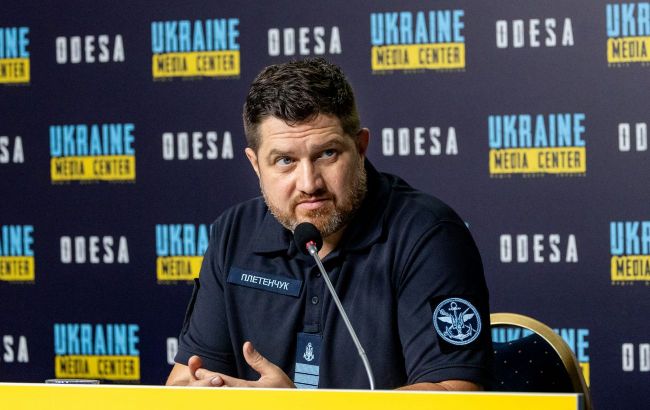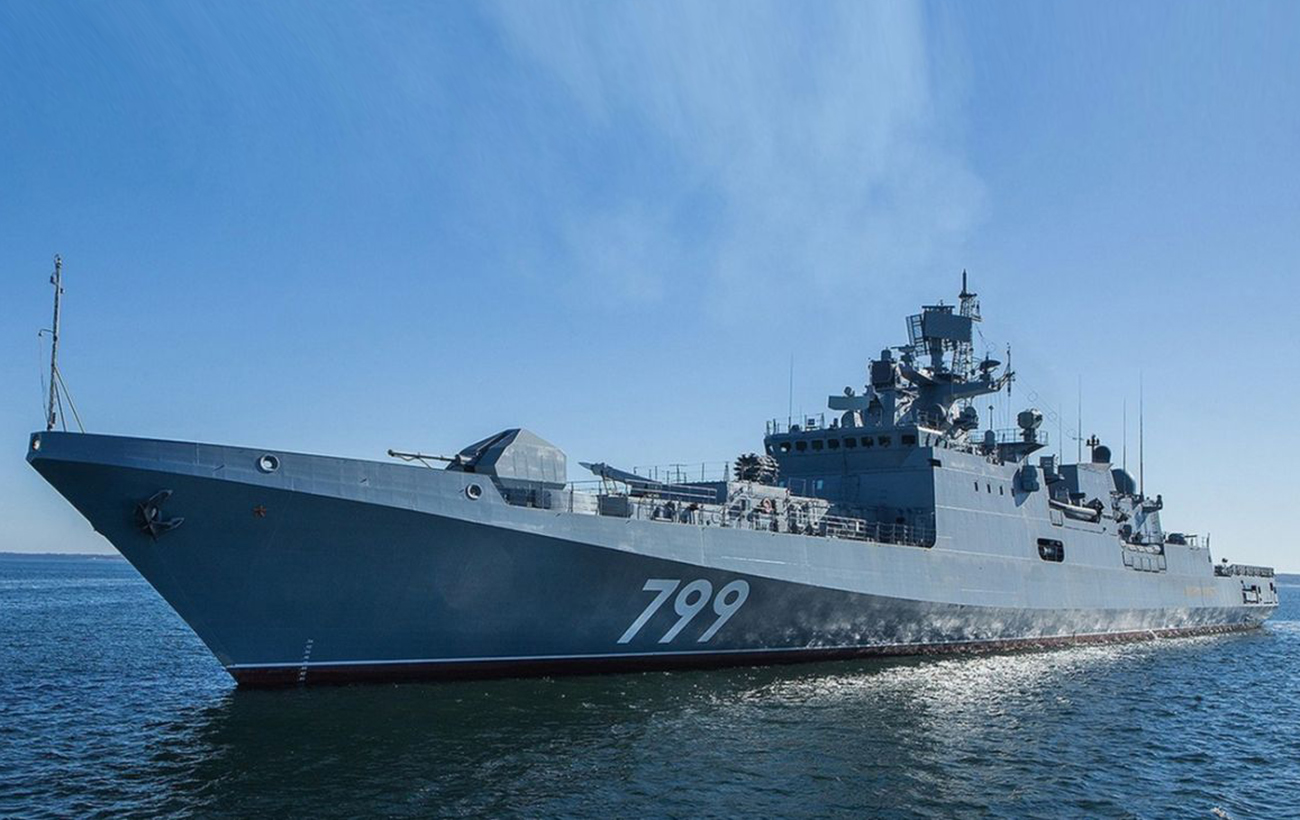Ukrainian Navy spokesperson: A third of Russian Black Sea Fleet already out of commission
 Dmytro Pletenchuk, spokesperson of the Ukrainian Navy (Photo: Facebook)
Dmytro Pletenchuk, spokesperson of the Ukrainian Navy (Photo: Facebook)
In an interview with RBC-Ukraine, Dmytro Pletenchuk, spokesperson of the Ukrainian Navy, discussed whether the Russian fleet has been driven out of the Black Sea, why the aggressor has taken a long pause in using Kalibr missiles, how the grain corridor has been organized without Russia, and how the occupiers are supplying their forces in the South after the latest damage to the Crimean Bridge.
Contents
Since the beginning of the full-scale invasion, Russia aimed to cut Ukraine off from the sea. To achieve this, the aggressor occupied the southern parts of the Zaporizhzhia and Donetsk regions, thereby controlling the entire Azov Sea coast. Simultaneously, the enemy planned to advance to Odesa to take control of the entire northern coast of the Black Sea.
During the first year of the large-scale war, the enemy was pushed back to the south across the Dnipro River. Consequently, all their plans for dominance in the Black Sea started to fade. Despite Moscow's obstacles, Ukraine managed to keep the grain corridor from the Odesa ports operational. The defense forces regularly destroy the so-called Black Sea Fleet and missile carriers. The occupiers' ability to land amphibious assaults has also significantly decreased. The enemy now has only a third of the ships capable of such operations.
The retreat of the Russian fleet from Crimea
Since the beginning of Russia's full-scale invasion, the Ukrainian Navy, along with other components of Ukraine's security and defense forces, has liberated more than 25,000 square kilometers of maritime territory. This includes the northern, western, southwestern, and central parts of the Black Sea.
According to the Ukrainian Navy, Russia has generally decided not to deploy its fleet in the Black Sea after suffering significant ship losses. Instead, Moscow has opted for a presence in the form of submarines. Currently, the Russian Black Sea Fleet comprises four submarines, three equipped with cruise missiles. However, one of these submarines has not been deployed to sea, possibly due to technical issues, as speculated by Dmytro Pletenchuk.
"Over the past six months, their primary tactic has been to hide at their bases in Novorossiysk and Sevastopol. Following the destruction of the small missile ship Askold, it became extremely inconvenient for them to remain in Sevastopol, leading them to withdraw six more units from there," explained the Ukrainian Navy spokesperson.
He noted that the Russian naval base has already been relocated from occupied Crimea to Novorossiysk. Currently, they have decided to move several ships to the Sea of Azov, likely for training purposes, where there is a group of eight ships.
"They might believe that their ships are safer there, considering that the Kerch Strait poses an obstacle to drones and is narrowed by barges with boom barriers. Therefore, they probably feel more secure there. They are also hiding behind civilian vessels, as they have always done," Pletenchuk explained.
Additionally, Pletenchuk mentioned that aside from training, the Russians are using Azov Sea ports to transport looted goods from occupied territories, including metal and grain, primarily through Mariupol.
Unfortunately, despite the Russians feeling unsafe at sea, their air dominance remains, with reconnaissance drones, fighters, and bombers still present, according to the Ukrainian Navy.
Why has Russia reduced the use of Kalibr missiles in strikes on Ukraine
Pletenchuk says that after hastily relocating their naval base from Sevastopol to Novorossiysk, the missile loading systems remained in Crimea for some time.
Even if they managed to equip Novorossiysk to reload submarines with missiles, there are still questions about whether they can load missiles onto surface ships there.

Photo: Facebook
"This requires different equipment. It's not overly complicated, but they struggled for quite some time to resolve this issue, even for submarines. Most likely, they have resolved something regarding reloading submarines in Novorossiysk, as the last three attacks (excluding the single shot at Mykolaiv) came from submarines. This indicates that they were reloaded but did not go to Crimea," Pletenchuk explained.
At the same time, submarines can launch a maximum salvo of four missiles, while surface ships can launch eight. Another reason for the less active use of Kalibr" missiles could be their diminishing effectiveness.
"The nuance is that these missiles are no longer as effective as they were at the start of the full-scale invasion. We have learned how to counter them. They mostly use Kalibr missiles during combined missile attacks to achieve success through sheer numbers, aiming to overwhelm our air defenses. They believe they might have some chances this way. However, Kalibr missiles are practically no longer used as a standalone weapon," Pletenchuk said.
How the grain corridor was organized without Russia
Despite not extending the grain agreement due to Russia, Ukraine and its allies established an alternative route for ships carrying grain from Odesa ports.
Previously, under the grain agreement with Russia's participation, the route from Odesa to the Bosphorus was direct - through open sea, not via NATO countries' territorial waters. Russia exploited international law under the United Nations Convention on the Law of the Sea to establish control over these waters. According to this convention, any country in the region can declare a section of the sea closed for military exercises, for example.
"What the Russians did was simply continuously block sections of the sea along that corridor because they could physically be present in the western and southwestern parts of the Black Sea with their combat and patrol ships. When they close these sections, they can patrol them to ensure the safety of civilian shipping. Meanwhile, civilian vessels have no right to enter these areas," Pletenchuk explained.

After Russia withdrew from the grain deal, grain transportation continues without its participation (photo: GettyImages)
Moreover, the Russians constantly sent inspection teams to delay the process, ensuring no more than 10 ships could pass through in a day.
Most of the current corridor runs through the territorial waters of NATO member countries: Romania, Bulgaria, and Türkiye. Territorial waters - 12 nautical miles from the coast - are sovereign territory according to international law. For Russia, this territory remains untouchable.
"They can make threats on their TV, but they understand very well that they cannot afford to engage in direct confrontation with NATO. Consequently, the part in our waters, where the enemy tried to operate for a long time, remains," Pletenchuk said.
He noted that the Russians have not stopped trying to disrupt the new grain corridor's functioning. They have directed ballistic missiles at port infrastructure and shipping routes and attempted to mine the area by dropping bottom mines from planes in containers.
"Russian aviation dominates the skies, but we mostly repel their air attacks. They don't want to hit a ship under a foreign flag. Mine safety, anti-sabotage activities, patrolling, convoying - these are all carried out by the Navy with our forces and resources. We conduct this daily work to ensure safety in this area, which are our territorial waters," the Navy spokesperson said.
Losses of the Russian Black Sea Fleet
According to the Ukrainian Navy, a third of the Russian Black Sea Fleet has been rendered inoperable. Ukrainian Defense Forces have managed to destroy 28 Russian ships, including about 15 significant vessels for Russia, from the flagship to four large second-rank landing ships. The only first-rank ship was the cruiser Moskva.
Among these are three Kalibr missile carriers: the small missile ships Askold and Tsiklon and the submarine Rostov-on-Don. The Russians still have eight left. After the destruction of Askold, Russia no longer has missile carriers in occupied Crimea.
The enemy's landing capabilities are also significantly reduced. Of the 14 large landing ships, only five remain operational. More than 10 ships have been sent for repairs after engagements with Ukrainian Defense Forces.
"But many of the ships currently in service have also sustained damage. For example, both frigates, Admiral Essen and Admiral Makarov. Many of the enemy's ships have encountered both drones and missiles. Some have been repaired, some are still under repair, and some will be out of service for a long time due to serious damage," said Pletenchuk.

One of Russia's few remaining missile carriers is the Admiral Makarov frigate (photo: rosmedia)
Crimean Bridge
According to Pletenchuk, the Crimean Bridge now does not have the same impact as it did before.
"For military logistics, it is hardly used. Less than a quarter of the total load is carried by this bridge. The rest goes via the ferry crossing, which was recently attacked. Therefore, the bridge no longer holds significant tactical and strategic importance after the damage it sustained from the joint operation by the SSU and the Navy with drone attacks," said a Navy spokesperson.
Pletenchuk added that Russia is currently constructing a railway in the occupied territories of the Azov region. This will be a lateral railway specifically to supply the grouping of occupiers in the South. According to Pletenchuk, the project is expected to be completed by the end of this year. It will run from Rostov along the coast of the Sea of Azov to Dzhankoi. However, there is a problem with it - it is within the range of Ukrainian Defense Forces' strike capabilities.

